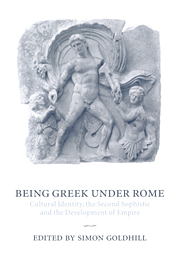Book contents
- Frontmatter
- Contents
- List of contributors
- Introduction: Setting an agenda: ‘Everything is Greece to the wise’
- 1 Subjected to Empire
- II Intellectuals on the margins
- 4 Describing Self in the language of the Other: Pseudo (?) Lucian at the temple of Hierapolis
- 5 The erotic eye: visual stimulation and cultural conflict
- 6 Visions and revisions of Homer
- III Topography and the performance of culture
- List of works cited
- Index of major passages discussed
- General index
5 - The erotic eye: visual stimulation and cultural conflict
Published online by Cambridge University Press: 22 January 2010
- Frontmatter
- Contents
- List of contributors
- Introduction: Setting an agenda: ‘Everything is Greece to the wise’
- 1 Subjected to Empire
- II Intellectuals on the margins
- 4 Describing Self in the language of the Other: Pseudo (?) Lucian at the temple of Hierapolis
- 5 The erotic eye: visual stimulation and cultural conflict
- 6 Visions and revisions of Homer
- III Topography and the performance of culture
- List of works cited
- Index of major passages discussed
- General index
Summary
sex and sex and sex and sex and look at me
Mick JaggerWhen an exhibition of Robert Mapplethorpe's photographs became the subject of legal challenge in Cincinnati in 1990, the prosecution of the gallery and its director had a simple, if scarcely innocent, strategy. Rather than make an intricate case, they just showed the pictures to the carefully selected jury – only three of which ‘local community members’ had ever been in an art gallery in their lives. ‘You're going to ask, “Shouldn't we hear something more?”,’ declared Frank Prouty, the chief prosecutor, The pictures are the State's case.‘The corrupt and stimulating imagery was to speak for itself. Look and you will see. The defence, however, framed the pictures with a mass of expert academic evidence – attacking the prosecution's knowing display with a display of knowledge. As with the Lady Chatterley trial, the paraded discourse of the academy swayed the good men and true, and the exhibition was acquitted of the charge of pornographic display. This time, the thousands of words were worth more than a picture, and the game of ‘show and tell’ was won by the team from the academy: ‘The prosecution basically decided to show us the pictures so that we'd say that they weren't art when everybody was telling us they were.’ The scandal, however, has remained a test-case of culture wars – which Senator Jessie Helms took to the floor of the Senate itself – and it has become an icon and a staple of cultural studies.
- Type
- Chapter
- Information
- Being Greek under RomeCultural Identity, the Second Sophistic and the Development of Empire, pp. 154 - 194Publisher: Cambridge University PressPrint publication year: 2001
- 24
- Cited by



